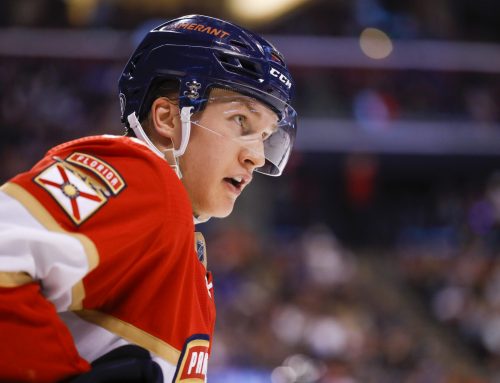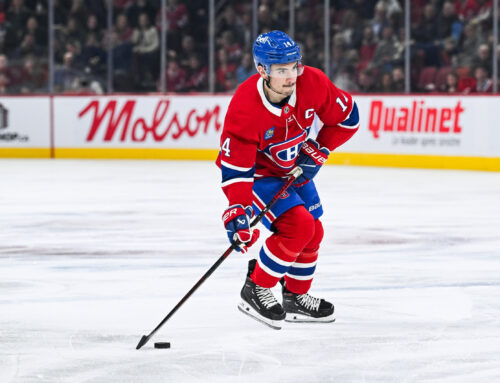
It’s been months since I last did a defensemen match-up, so I’m teeing up a rearguard battle here before returning next week with a perennial DobberHockey favorite – winter cage match tournaments.
I’m also doing something I’ve rarely done, which is repeating a cage match – Ryan Suter vs. Duncan Keith. But considering their last contest occurred nearly five years ago, I figured enough has happened since then to go down this same road again. So let’s dive in and see which of the two is the better own.
Career Path and Contract Status/Cap Implications
Suter, son of Miracle on Ice hero Bob and nephew of former fantasy darling Gary, was drafted seventh overall in 2003. In the NHL for good in 2005-06, for seven seasons he was an integral part of Nashville’s bedrock defense corps before signing with Minnesota in 2012. From 2008-09 to 2014-15 Suter was a mark of consistency, with 37-46 points each full season and missing a total of only 20 games. Then out of the blue he posted 51 points last season at age 30, reopening the eyes of poolies in the process.
Keith, 33, was drafted 54th overall in 2002. After another year in juniors Keith landed in the AHL and posted only 51 points in 154 total games. Nevertheless, Chicago saw enough to make him, like Suter, an NHL regular in 2005-06; and Keith responded by managing to up his point total in four straight seasons, from 21, to 31, to 32, to 44, and then, amazingly, to 69. Those who figured Keith had morphed into a prolific scorer were left sadly disappointed, however, as he dipped to 45 points the next season then to 40 in 2011-12. Just when poolies had resigned themselves to Keith being a one hit wonder, in 2013-14 he spiked to 61 points, only to come back to earth somewhat, with a very solid but not spectacular 88 points in 147 games over the last two seasons.
Both players are on 13 year deals. Suter’s carries a cap hit of $7.538M per season and ends in 2024-25, while Keith’s dings the cap at a much cheaper $5.538M yearly and runs until 2022-23.
Ice Time
|
Season |
Total Ice Time per game (rank among team’s defensemen) |
PP Ice Time per game (rank among team’s defensemen) |
SH Ice Time per game (rank among team’s defensemen |
|
2016-17 |
26:58 (R.S.) – 1st 26:09 (D.K.) – 1st |
2:54 (R.S.) – 1st 3:34 (D.K.) – 1st |
2:36 (R.S.) – 1st 2:30 (D.K.) – 2nd |
|
2015-16 |
28:35 (R.S.) – 1st 25:14 (D.K.)- 1st |
3:40 (R.S.) – 1st 2:48 (D.K.) – 2nd |
1:57 (R.S.) – 1st 2:40 (D.K.) – 2nd |
|
2014-15 |
29:03 (R.S.) – 1st 25:33 (D.K.) – 1st |
3:49 (R.S.) – 1st 3:20 (D.K.) – 1st |
2:03 (R.S.) – 4th 2:20 (D.K.) – 2nd |
|
2013-14 |
29:24 (R.S.) – 1st 24:38 (D.K.) – 1st |
3:46 (R.S.) – 1st 3:10 (D.K.) – 1st |
2:21 (R.S.) – 1st 2:23 (D.K.) – 2nd |
Suter’s Total Ice Time decreased in each of the past two seasons; yet he had markedly better scoring in 2015-16 versus 2014-15 and 2013-14. Of course to poolies it’s normally counterintuitive sacrilege to suggest a “less is more” approach to Ice Time; but in this case the results seemingly support the idea that by playing fewer minutes Suter benefitted, especially as the season progressed.
In 2013-14, Suter played 26 games from February onward, posting ten points. In 2014-15, with 21 seconds less Total Ice Time, his per game production during the same time period was a bit better and he played 25% more games (13 points in 33 games). Then last season, after shedding 28 more seconds of per contest Ice Time, he played in more games (34) during that same stretch and posted far more points (20) than either 2013-14 or 2014-15. Of course we’ll check whether luck (good and/or bad) was behind what happened in any of these seasons, but on paper it looked like a win-win approach.
Fast forward to now, however, and things have gone overboard. That’s because unlike in past seasons (when Suter shed 20-30 seconds in Total Ice Time each season, plus lost some SH Time while his PP Time stayed steady), for 2016-17 his Total Ice Time per game has decreased by 1:37, his PP Ice Time is down nearly 30%, and his SH Time has spiked upward 33%. Yet Suter is still on track for a 49 point season. So that must mean this late career production spike is for real, right? Very unlikely.
Just like last week when we saw that James van Riemsdyk’s early 2016-17 production was a mirage, data suggests Suter also will likely come back to earth before all is said and done for 2016-17. For one, Suter’s SH Time is now high enough to act as a production barrier. After all, looking at the past three seasons, of 32 instances of d-men scoring 50+ points, only five had over 2:30 of SH Ice Time in the same campaign. Beyond that, the average number of goals among the five in their 50+ point season was 15 (nearly double Suter’s career high of eight) and their average PP Time was 3:10 (0:16 more than Suter).
Meanwhile, it’s baffling that Keith scored 61 points in 79 games in 2013-14 but 88 points in 147 games (49 point pace) over the next two seasons. After all, compared to 2015-16 and 2014-15, his 2013-14 Total Ice Time was the lowest of the three campaigns, and his PP and SH Times were both higher than one season but lower than another. Apparently, Ice Time alone can’t explain the very significant gap in production between these seasons.
Beyond that, Keith’s 2016-17 production (52 point pace) is also somewhat suspect, since he’s right at the 2:30 per game SH Ice Time threshold and, with one goal through 34 games, likely will fall far short of double digit goals. Yet he’s getting well more than 3:10 PP time, so that might be a saving grace.
Secondary Categories
|
Season |
PIM (per game) |
Hits (per game) |
Blocked Shots (per game) |
Shots (per game) |
PP Points (per game) |
|
2016-17 |
0.46 (R.S.) 0.18 (D.K.) |
0.96 (R.S.) 0.36 (D.K.) |
1.10 (R.S.) 1.06 (D.K.) |
1.93 (R.S.) 2.18 (D.K.) |
0.23 (R.S.) 0.18 (D.K.) |
|
2015-16 |
0.36 (R.S.) 0.39 (D.K.) |
0.84 (R.S.) 0.24 (D.K.) |
1.73 (R.S.) 1.73 (D.K.) |
2.29 (R.S.) 1.94 (D.K.) |
0.25 (R.S.) 0.27 (D.K.) |
|
2014-15
📢 advertisement:
|
0.62 (R.S.) 0.25 (D.K.) |
0.89 (R.S.) 0.20 (D.K.) |
1.65 (R.S.) 1.41 (D.K.) |
1.95 (R.S.) 2.13 (D.K.) |
0.14 (R.S.) 0.20 (D.K.) |
|
2013-14 |
0.41 (R.S.) 0.35 (D.K.) |
0.86 (R.S.) 0.45 (D.K.) |
1.58 (R.S.) 1.12 (D.K.) |
1.83 (R.S.) 2.50 (D.K.) |
0.20 (R.S.) 0.26 (D.K.) |
First we’ll look at SOG and PPPts to see if they help explain each player’s outlying season, plus how they might influence the sustainability of their 2016-17 early outputs. For Suter, his 2015-16 SOG rate was up 10% versus his two prior seasons and his PPPt rate up nearly 20%, so that could support 2015-16 being an outlier. This season, despite a scoring rate that’s nearly identical to last season, he’s back down to his 37-45 point SOG rate; and although his PPPts is still higher than his normal rate it’s down from last season. In other words, more red flags for 2016-17.
As for Keith, he too had his best SOG rate in his most productive (i.e., 2013-14) season; but his PPPt rate wasn’t anything unusual. In short, there’s nothing to suggest he should’ve produced much better, if better at all, in 2013-14 versus 2014-15 or 2015-16, which means luck metrics might hold the key. Also Keith doesn’t have 2016-17 red flags a la Suter; in fact, Keith’s SOG rate is decent and his PPPts rate is markedly down, suggesting it actually might have room to grow. Luck metrics will tell us a lot more.
In terms of other data, Keith is a proven drain in PIM and Hits, although if your league counts Blocks that used to help lessen the negative impact. However, his Blocks are down considerably this season and his already poor PIM are especially lousy, making a bad situation apparently worse. As for Suter, he’d been about as consistent as they came in terms of Hits and Blocks outputs; however, he too has seen his Blocks rate fall this season thus far.
Luck-Based Metrics
|
Season |
Team Shooting% (5×5) |
Offensive Zone Starting % (5×5) |
IPP (5×5) |
IPP (5×4) |
|
2016-17 |
11.24% (R.S.) 6.72% (D.K.) |
47.9% (R.S.) 53.6% (D.K.) |
28.1% (R.S.) 35.0% (D.K.) |
87.5% (R.S.) 50.0% (D.K.) |
|
2015-16 |
7.60% (R.S.) 6.71% (D.K.) |
53.0% (R.S.) 45.7% (D.K.) |
32.8% (R.S.) 43.9% (D.K.) |
56.7% (R.S.) 56.5% (D.K.) |
|
2014-15 |
7.45% (R.S.) 7.14% (D.K.) |
56.4% (R.S.) 54.4% (D.K.) |
31.2% (R.S.) 35.5% (D.K.) |
50.0% (R.S.) 60.9% (D.K.) |
|
2013-14 |
8.24% (R.S.) 9.03% (D.K.) |
54.3% (R.S.) 56.0% (D.K.) |
34.4% (R.S.) 45.5% (D.K.) |
46.9% (R.S.) 60.7% (D.K.) |
Finally we see some explanation for Keith’s 61 points in 2013-14. All his metrics that season were either virtually tied for the highest (5×4 IPP) or the highest (the other three areas) versus 2014-15 and 2015-16, most notably his 5×5 Shooting percentage being well higher than these other seasons – high enough, in fact, to likely account for those extra points. And sure enough – his second highest full season 5×5 team shooting % (8.97%) was in his 69 point 2009-10 season, so that does appear to hold the key.
If we’re looking at Keith’s past numbers to judge how the rest of 2016-17 might unfold, the bad news is he’s not near his 60+ point levels for 5×5 team shooting %; however his lower 5×4 IPP suggests he should see an uptick in his PP scoring, as does his 5×5 IPP. All in all, this helps form a picture of a player who should be able to sustain a 2016-17 scoring pace at or above 50 points, which, amazingly, would mark his first time tallying between 46 and 61 points in any season.
For Suter, we see a higher than normal 5×4 IPP for 2015-16, which seemingly is what pushed him above the 50 point threshold. But where real trouble signs exist are for this season, as his 5×5 team shooting % ranks him highest among 123 d-men who’ve played 400+ minutes at 5×5 and his 5×4 IPP puts him fifth among 65 rearguards who’ve logged 50+ minutes at 5×4. That’s very unsustainable good luck, which, when coupled with the Ice Time and SOG warning signs noted above, collectively plaint a gloomy picture for Suter’s production over the rest of 2016-17.
Who Wins?
This is a slam dunk win for Keith in one-year leagues. Keith’s current production (already better than Suter’s) might actually hold steady, whereas several signs point to Suter’s being in very real danger of plummeting. If you have Suter in a one-year league, make it your top priority to trade him ASAP.
But notice I didn’t say to get Keith in one-year leagues. The reason why is also what makes it more difficult to decide a winner of this match for keepers. Keith’s cost vs. value is significantly affected by what I call the “Habs factor,” which inflates the cost of the most well-known players on the most widely followed teams. And let’s face it, there aren’t many teams more widely followed than the Hawks nor defensemen more well-known than two-time Norris and 2015 Conn Smythe winner Keith, whereas the Wild and Suter simply aren’t in the same stratosphere. Sure enough, although their scoring paces last season were comparable, Suter is the better multi-cat option, and Keith is 18 months older, Keith was nevertheless selected, on average, more than 40 spots earlier than Suter in Yahoo drafts for 2016-17.
Even still – I’m picking Keith in keepers. Not only am I concerned about the warning signs for Suter, but Suter also has more talented d-men around him to siphon away points and/or Ice Time in the future. For Keith, even though he’s older his prominent place on the Blackhawk blueline is virtually ironclad. And there’s also the fact that the Blackhawks have better fantasy talent to surround Keith, which in turn will help him produce more down the road.
4 Comments
Leave A Comment
You must be logged in to post a comment.





 PHI
PHI TOR
TOR ANA
ANA NYI
NYI BUF
BUF CGY
CGY VAN
VAN CAR
CAR STL
STL MTL
MTL

I would really like to know what is up with Torey Krug. He plays 24 minutes a game with 4 minutes on the pp, averages nearly 3 SOG per game, and yet he can barely get to 40 points. A shooting % of less than 2% over a season and a half. His shot selection can’t be that bad, he’s getting them on goal, as opposed to pounding it into the defender in front of him. Granted, excluding his first 8 games this year, he’s right back on that 40 point pace, but with his numbers, he ought to be 45-50. What’s the deal?
I did a cage match with him against Rasmus Ristolainen back in February so it would be a bit too soon for me to tee him up again. But I think part of it is Boston just not scoring much this year and Krug feeling like he has to carry more of the load himself, hence him still shooting a lot but it failing to translate to more points. I think he’s a solid buy low, if only because he’s got nearly zero risk due to no other offensive-minded defensemen on Boston and the fact that he’s yet to finish a season averaging less than a point per every other game.
If you do another one of these that has you revisiting an old or, as in this case, a very matchup; it would be nice to have either a link to the prior one, or a synopsis of what was said then.
Guess you missed the link to the old one right at the beginning of the column, in the second paragraph where it says “last contest”.